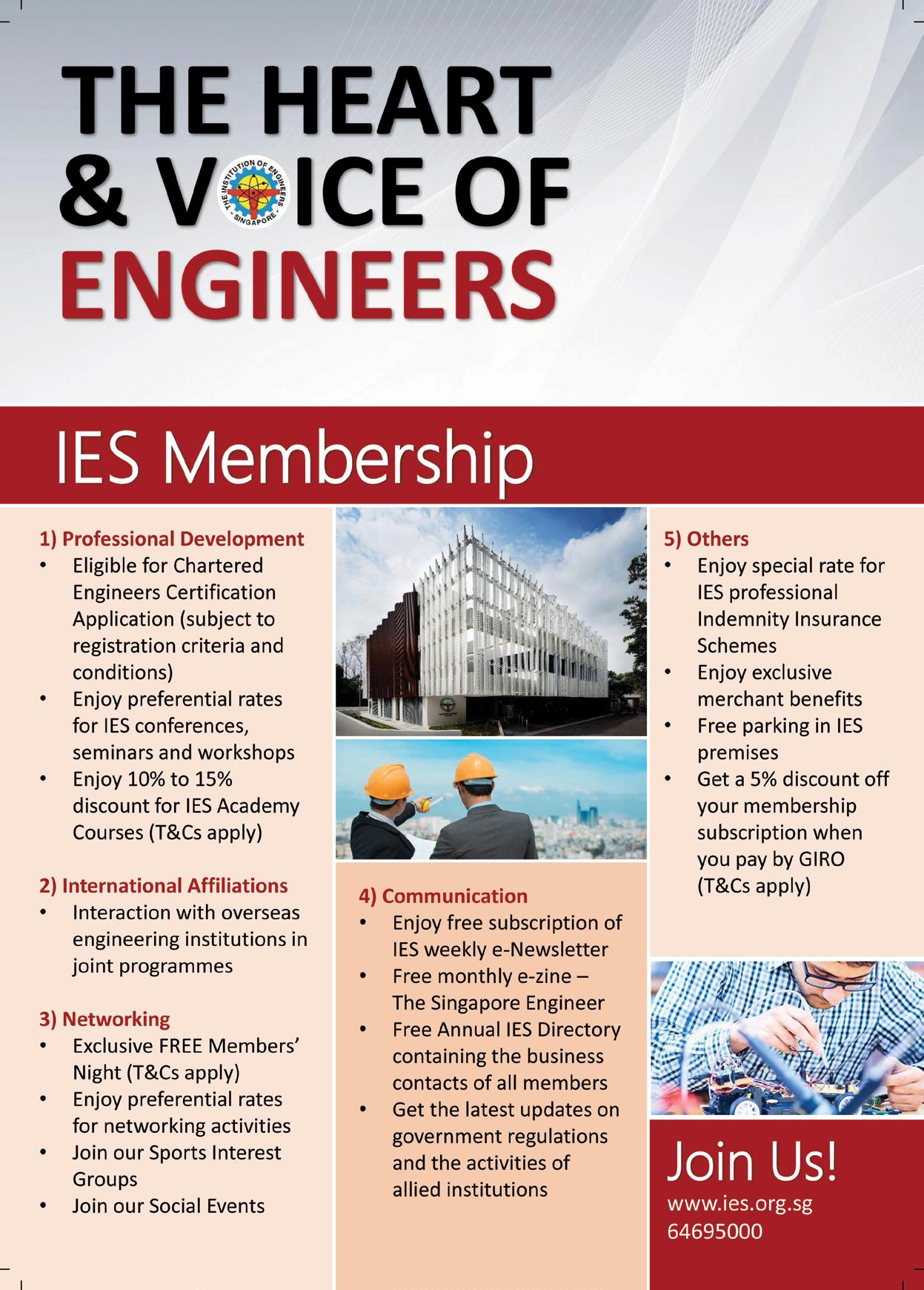
35 minute read
Innovative technologies for people movement in high-rise buildings They will make buildings smarter, safer and more adaptable to a changing urban environment
FUTURE ADVANCES IN PROCESS AUTOMATION
Andrew Ogden-Swift reviews the pressing challenges
Over the last 40 years, there has been continual growth in the use of digital technologies in process manufacturing. This has ranged from increasingly reliable and low-cost sensors, digital field networks, control and shutdown systems, process historians, model-based optimising controllers, and manufacturing information systems, to enterprise resource planning systems. These technologies have enabled higher process performance, reduced operating risk and improved staff productivity. Improvements in these technologies continue: • Continued improvements in self-diagnostics, error prevention, precision in field instruments and valves along with continued cost reduction and instrument asset management. • Better control systems capabilities such as configurable
I/O and tools that ensure control systems are no longer on the critical path of new build projects. Better tools and new modules to reduce the cost of system maintenance, migration and sustaining IP in existing systems. Better approaches and technologies to build operator interfaces. • Better control loop maintenance and advanced control including distributed MPC and site-wide real time dynamic optimisation. • More integrated manufacturing execution systems. • Better technologies and approaches to manage cyber security risk. In the broader world, there are trends that will impact the process industries and enable further performance improvements and help mitigate loss of expertise. They will also contribute to improved sustainability of these industries.
Technology Area: Big Data and Analytics
The trends in digital computing and mobile technologies now mean there are huge amounts of information about people and their behaviours, appliances and equipment, and the environment. Increasingly, companies are analysing these data to help make better decisions, faster. We are all familiar with internet-based systems recommending other purchases based on the items we have selected, or adverts presented to us based on entries made. Similar opportunities exist in manufacturing with some challenges that are specific: • To be successful, subject matter experts need to use modern analytical tools. Subject matter experts such
–––––––––––––––––––––––––––––––––––––––––––––––Mr Andrew Ogden-Swift CEng, MIChemE is Director at Ogden-Swift Consulting, UK as engineers, managers and operators seldom have a strong background in statistics, machine learning and
AI. Similarly, data scientists seldom have good understanding of process manufacturing. Tools are needed that enable subject matter experts to perform analyses and yet collaborate with data scientists on the more complex problems. • Data is stored in disparate systems. There are usually data quality issues including missing data, different sampling rates and temporal misalignment, signal and process noise, measurement uncertainty and the relationship with business risk. Tools need to make it easy to access, align and cleanse data. • Process analysis needs to make it easy to answer common questions but in ways that make sense by, for example, allowing for grades, operating modes, and feedstocks. • Analysis needs to allow fast results to be achieved, effective collaboration, issues to be communicated quickly and improvements to be driven rapidly. Increasingly, tools are becoming available that meet these needs and enable engineers and managers to analyse performance without the grind of trying to use spreadsheets or become data science experts.
Technology Area: Mobility
It might seem strange to see mobility identified as a technology that will have significant impact in manufacturing. After all, we have all had mobile phones for a couple of decades. Mobile tools have been increasingly used over the last 5-10 years to enable field workers to be effective, for example, to carry out and collect data from operator rounds. The key challenges for mobility in process operations are use in hazardous environments, use in hands-free and high noise environments. Increasingly these problems are being overcome with integration with ear protection (along with noise cancellation) and near-to-eye displays providing augmented reality. Provision of effective applications interfaces and analytics will empower mobile workers to create significantly higher value.
Technology Area: Edge and Fog Computing
With continued growing capability of microprocessors and communications technologies, increasing computational capability will be available in controllers and other digital devices (edge computing) which are located at the plant. Moreover, these devices will allow more complex and sophisticated algorithms to be implemented close
Example of prediction of reactor end-of-catalyst life. Image: Seeq Corporation.
to equipment and communicate effectively with higher level analytical platforms.
Technology Area: Open Systems
In some sectors of the process industries, highly integrated distributed control systems have been used. The integrated nature of these systems makes it more difficult to incorporate new components into the system allowing the site to take advantage of lower cost options or new innovations. Over the last few years new architectural concepts have been prototyped which would allow operating companies to leverage new components effectively at the lower levels of the control system.
Technology Area: Computer/Human Interaction
In addition to the mobility theme addressed above, there is a wide range of other new approaches being developed that enable us to interact with digital systems. Voice recognition and synthesis is becoming increasingly widespread but other approaches such as augmented reality, gesture-based interaction and eye tracking may start to be used. Significant improvements have been demonstrated by improvements in design of operator displays through work by the Abnormal Situation Management Consortium and Center for Operator Performance. These approaches can be expected to be more widely applied and enhanced by further human factors research.
Technology Area: Cloud
Increasingly, information and decision support systems are being moved to being hosted on the cloud. The primary driver for this is reduction in the cost of systems and applications management. Companies no longer have to buy and maintain servers nor upgrade applications when new releases or patches are issued - these are managed by the cloud service vendor. New usage and payment models are enabled, such as pay-per-use. Cloud platform providers are developing new AI and machine learning technologies which will further improve analytics results. Some are also actively investing in time series data stores which will see new entrants into this market and price compression of process historians.
Summary
The digital transformation journey that many process manufacturing companies have been on for decades is accelerating with more capable electronic and software platforms and new algorithms. This will drive continued improvements in process safety, emissions to the environment, production results and working capital. This is in spite of continued loss of expertise in the industry and ever-rising regulatory demands. New emerging architectures and technologies will see current systems and architectures become obsolete, threatening incumbent suppliers and new, innovative capabilities will create higher opportunities for higher business results and productivity.
[Adapted from an article written by Mr Andrew Ogden-Swift and included in the October 2019 Issue of ‘The Chemical Engineer’, published by the Institution of Chemical Engineers (IChemE)]
ENABLING SMARTER REVENUE GENERATION IN THE PETROLEUM REFINING INDUSTRY
Leading petroleum refineries are continuously pressured to achieve, sustain and reach the next level of performance. Ravi Gopinath, Chief Product and Cloud, AVEVA, looks at how digitalised operations and processes can help to accelerate decision-making and boost revenues.
Downstream business processes commonly refer to the petroleum industry and are associated with post-production activities. Leading petroleum refineries are continuously pressured to achieve, sustain and then reach the next level of performance. In the ongoing quest for value Mr Ravi Gopinath creation, businesses are also seeing a new wave of technology-enabled productivity growth. This is acknowledged in McKinsey & Company’s research on ‘Digitising the Value Chain’, which states that 80% of operations agree that digitalisation is a critical driver of competitiveness. In monetary terms, digital transformation in the oil and gas industry could unlock approximately USD 1.6 trillion of value for the industry, its customers and the wider society. This total estimated value from digitalisation can further increase to USD 2.5 trillion if existing organisational/operational constraints are relaxed, and the impact of futuristic technologies, such as cognitive computing, is considered. Digitalisation has the potential to create around USD 1 trillion of value for oil and gas firms. Digitalisation is gaining momentum. It enables management to receive real-time operational information in an integrated manner and can help businesses break through to the next level of performance in three key ways: • Unlock hidden or captive value: Performance gains made by early adopters of Refining Operations Management show significant contribution to profitability goals and invested capital. • Close the digital operations gap: Addressing the steps in an end-to-end refinery value chain as an integrated whole is driving the next productivity frontier in petroleum refining. Although it goes by different names (Digital, IoT, Industry 4.0), they all reflect a common theme of digitalisation of business processes, with huge potential especially for areas like operations management. • Enable a step change in process: Unlocking hidden value requires dealing with events closer to real time - in particular, the many minor performance deviations or ‘value leaks’ that occur daily.
UNLOCKING HIDDEN POTENTIAL
To understand the performance improvement potential in quantitative terms, consider the benefits to a 400,000/ bpd refinery from integrated refinery information management processes. • Revenue increase achieved through improved availability and yield is more than USD 67 million per year per percent improvement. • Energy efficiency increase of at least 4%, which is worth more than USD 20 million per year, is achieved through proactive operations and closer coordination through the ‘internal value chain’. • Further cost reductions achieved through logistics improvements within the ‘internal value chain’ is more than USD 60 million per year per percent improvement. In qualitative terms, the deployment of Refining Operations Management achieves further improvements in the following ways: • Enabling planning with accuracy: Refining Operations Management enables planning and scheduling processes to tightly couple with supply chain and operations management and allows accurate planning based on accurate demand forecasts and real plant constraints. • Allowing the plant to operate optimally, reliably and safely, while meeting targets: Applications like Operator Logbook, Operating Window, Offsites Management and others enable digitalised business processes and allow enhanced operator productivity and improved decision-making, while working within the operating envelope, to improve plant efficiency and asset lifecycle, as well as provide a safer and a more reliable operation. • Measuring performance with accuracy: This is achieved through tightly integrated quality management processes benchmarked against stringent quality standards, as well as a well-implemented real-time database, Laboratory Information Management
Systems (LIMS), mass and energy balance, production accounting and accurate plant models. A single version of truth is achieved through the seamless flow of validated data across all applications via an integrated environment. • Analyses performance with a collaborative analysis tool: The accurate and robust progress measurement

tool ensures a high level of integrity in reporting, rollup of individual KPIs to the corporate KPIs, powerful visualisation and event management, as well as seamless flow of validated data and designed version of truth. • Continuous improvement by agile decision-making based on reliable data: Well-designed business processes and workflow management leverage state-ofthe-art technology and industry standards.
REAL-TIME REPORTING TO REAL-TIME DECISIONMAKING
As an early adopter of both enterprise and real-time control systems, the petroleum refining industry is well into the digitalisation journey. Most operational applications were designed for reporting as opposed to real-time decision-making. As a result, the strategy-toexecution linkage is weak, preventing real-time visibility and agility. The current reality for operational users in the oil refining industry is that users do not have time to coordinate closely or take advantage of available data, especially data that could provide appropriate insight into upcoming refinery behaviours. The highly competitive nature of the refining industry has required higher levels of operational excellence. But with no relief in sight for margin pressures, there is a general recognition that in order to sustain the refining business under this ‘new normal’ we have to change the operational mindset. In other words, businesses need a step change in performance to be able to survive in the long term and ensure smart revenue generation. The key requirement for managing performance in real-time is that relevant information should reach the appropriate approval level quickly so that decisions can be made while the opportunity still exists or before the issue becomes a problem. All too often, the decision cycle takes too long and/or the action fails to impact the KPIs that matter to the business. What is needed is to compress the time within the decision loop while, at the same time, enabling informed decisions along the management hierarchy. This approach enables operations to deal with events closer to real time - in particular, the many minor performance deviations that occur daily. These minor deviations or ‘value leaks’, if undetected and left unchecked, slowly but surely erode profitability over time. Companies evaluating an integrated, real-time operational system like Refining Operations Management are encouraged to consider business decisions that would enable the right level of operational integration, in order to gain agility, so that the companies can adapt to changing business conditions and exploit new opportunities. Digital initiatives, if well executed, can unleash enormous
An external view of a downstream processing plant

opportunities in value creation
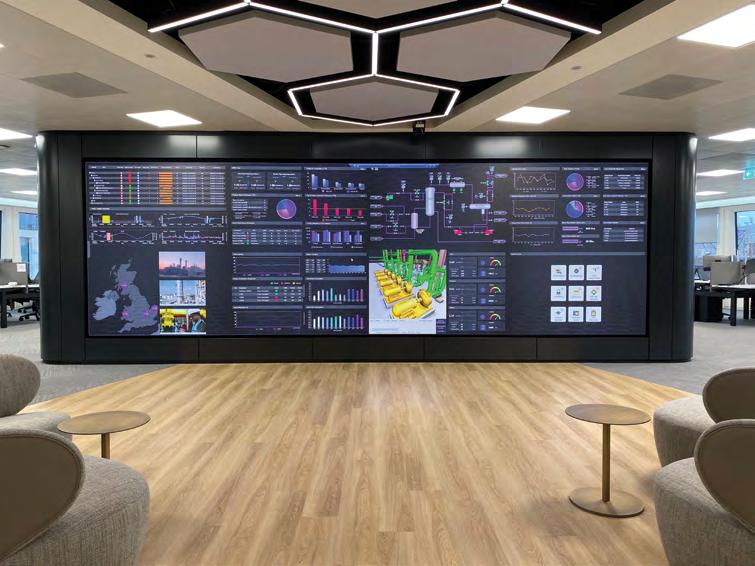
LEVERAGING TECHNOLOGIES FOR SMART FOOD PRODUCTION
by Ummi Syafiqah, Freelance Writer
The industry is adopting innovative methods.
Driven by rapid urbanisation and a burgeoning demand from a rising middle-class, Asia’s food manufacturing industry continues to prosper, despite the lingering COVID-19 pandemic. No doubt, the pandemic is adding pressure to the sector, as manufacturers and producers struggle to cope with the rapidly changing demands for consumer-packaged goods and a growing shift towards e-commerce and online purchasing. Functioning in an already labour-intensive and highly competitive industry with rising raw material costs and utility charges, retailers are now looking to technology and automation to push manufacturing beyond its limits, to improve food quality, output, and flexibility. A report by Meticulous Research predicts Southeast Asia’s industrial automation and process control market to grow to USD 4.97 billion by 2025, at a CAGR of 7.8%. To keep pace with the fast-moving digital commerce and adoption of a smarter approach, governments are investing heavily in the development and implementation of industrial automation and process controls. In July, Malaysia Digital Economy Corporation (MDEC) introduced the #SMART Automation Grant (SAG) as part of the government’s initiative to support small and medium enterprises (SMEs) in taking the leap towards automating their business processes. Similarly, Enterprise Singapore which champions enterprise development is promoting a customised approach towards encouraging businesses to adopt smart technologies. The government has also announced the Heartlands Go Digital programme to support the digital transformation of some 20,000 retailers and food and beverage (F&B) enterprises in the heartlands. Quality food production and technology advancements go hand-in-hand. Digital transformation not only offers food and beverage manufacturers a competitive edge but, more importantly, it helps to ensure product quality, from farm to table. With the capital push from governments, businesses are already leveraging connective technologies and solutions such as collaborative robots (cobots), intelligent networked devices and multi-product packaging systems to meet the increasing consumer demand for product diversity and transparency across the entire supply chain.
Robot-powered fulfilment solutions
As we experience an accelerating global shift towards e-retail, many business are finding it difficult to cope with repetitive labour-intensive tasks, while juggling logistics, order fulfilment and keeping up with the modern-day sophisticated consumer. With a growing demand from enterprises, industrial robots are automating specialised tasks that are transforming the food industry. According to research firm, Grand View Research, the global collaborative robots market size is set to expand at a CAGR of 44.5% by 2025. To accommodate the fast-expanding e-commerce industry, Universal Robots is achieving new levels of productivity with their collaborative industrial robots. The Quick Deployment Kit (QDK), developed by MDCI Automation, is a scalable solution for parcel induction, case packing, and goods-to-person tasks. While traditional industrial robots are usually programmed in protective cages to perform only one handling task, these cobots are encoded for flexible implementation. QDK can pick targets with a payload of up to 9.07 kg through a remote alerting technology. Utilising the UR10e cobot arm, alongside a powerful vision engine powered by PlusOne’s PickOne Software, the artificial intelligence (AI) enabled technology identifies items in a pick zone and sends them to the UR cobot that picks and places each item onto a place zone or a conveyor. Configurable from a menu of market-leading robot and gripper options with adjustable camera and lighting equipment, the adaptable technology is automated to be effortlessly integrated into a wide range of layouts including existing production lines. Additionally, the kit can keep up with fast-moving conveyor speed with a maximum robot speed of 1 m/s (39.4in/ sec). In the production and manufacturing sector, where speed, consistency and high levels of repetition are required, the intelligent and user-friendly robotics allow for straightforward time and space optimisation with greater accuracy.
Smart and accessible
When contaminated air comes into contact with food, the products are exposed to particles, microorganisms, water, and oil. These physical, chemical, and biological hazards compromise hygiene standards and can affect the taste, appearance, colour and shelf-life of the food products. A ubiquitous tool in food production and packaging operations, compressed air is critical to
consistently maintaining high quality standards during processes like product handling, canning, freezing, dehydration, labelling and bottle filling, and packaging. Manufacturers equipped with compressed air systems, with the ability to gather, compile, and analyse system data, are able to not only track and monitor food safety risks but also optimise energy and production efficiency. Leading air compressor specialist, BOGE is setting new standards for the networked control of air compressor stations. The newly launched airtelligence provis 3 is designed such that an unlimited number of compressors can be controlled, managed and monitored proactively, based on consumption. Facilitating communication, via Ethernet, between products from different manufacturers and enabling different devices to work safely and reliably, the BOGE control uses the OPC UA open data format. With the ability to integrate its 15.6 inch intuitive touch display remotely on the PC, tablet or smartphone, the sleek and user-friendly controller continuously monitors all compressed air treatments, such as compressed air filters and dryers, through the simple integration of pressure dew point sensors or fault messages. The visualisation includes that of network pressure, volume flow, capacity utilisation, trends, efficiency of each compressed-air station and electric power consumption and performance history. The webbased interface allows for real-time data to be called up and operated from anywhere and from any device. For efficient energy management, the high performance control algorithms select optimal combinations of compressors and components proactively, and determines the energy-intensive over-compression, thereby optimising operations for load run or idle times. With such defining features, BOGE’s airtelligence provis 3 guarantees high quality standards, reliability, durability and process integration at all times.
High precision product packaging
Conveyors improve efficiency and productivity in addition to elevating safety and the performance of distribution facilities, while reducing labour costs. However, as customer requirements and demands evolve, the need for innovative packaging solutions and strategies to save time and money are becoming even more critical. At the core of MagneMotion Solutions, Independent Cart Technology is a new generation of linear motors that provides significantly higher machine performance and flexibility, without undermining productivity, compared to conventional gear, chain and belt conveyors. Rockwell Automation’s iTRAK 5730 system enables smart, flexible and diversified multi-product packaging for food manufacturers. Designed with magnetic propulsion technology, the individually controlled carts can start and stop with high precision, reducing machine wear and increasing energy efficiency. Easily applicable, the system which allows for easy changeovers using pre-configured move profiles implemented with the push of a button, is also scalable and can be integrated into existing architectures as a stand-alone machine or as part of a much larger complex line. Thanks to its 50 mm minimum pitch, the technology is ideal for primary packaging applications, such as flow wrapping, end load cartoning, and form-fill-and-seal pouching. Its simulation capabilities allow manufacturers to create and virtually design a digital twin system which can be commissioned, demonstrated and used to virtually train workers. With features such as safe torque off, Safe Stop 1, a SIL 3, PLe safety rating and the ability to create safety zones, the iTRAK 5730 offers integrated safety by allowing motion to continue outside of the safety zone, even after a trip inside the zone. This mechanical solution, is the next step motion control, redefining speed and flexibility in automation.
Smart Manufacturing Ecosystems
As we progress to the Industry 5.0 standard, technology will stay grounded as the foundation of digitalisation - promising faster, safer and efficient output. For the manufacturing industry, real-time data, analytics and high precision machinery will become the defining and necessary features in the market. The early adoption of these dynamic technologies will go a long way to help food retailers achieve operational performance by meeting order fulfilment and logistics requirements.
The BOGE airtelligence provis 3 provides maximum energy efficiency, easy maintenance and customer flexibility.

With its magnetic propulsion technology, the iTRAK 5730 system enables smart, diversified multi-product packaging for food manufacturers.
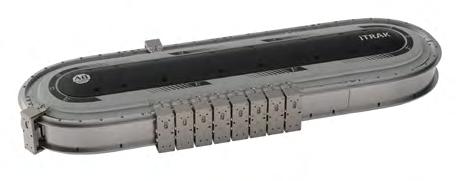
RESILIENCE IN A TIME OF UNCERTAINTY
Companies need to have plans for business continuity, disaster recovery and crisis management, to cope with situations such as a global pandemic.
Mr Albert Joseph Carreon, Head of Global Architecture, Directory Services & Collaboration, Coats, a UK-based industrial thread company, provides an overview of how the company has responded to the disruptions caused by the outbreak of COVID-19.
Mr Albert Joseph Carreon
‘The Singapore Engineer’: Can you tell us more about Coats?
Albert Joseph Carreon: Coats is the world's leading industrial thread company. Headquartered in the UK, we have a work force of 18,000 in some 50 countries across six continents around the world.
TSE: How did Coats handle the overall IT concerns during the pandemic? What was the biggest challenge faced?
AJC: The biggest challenge was how to manage remote working as most of the countries declared a total lockdown around March. It was a good thing that our leadership had anticipated this possibility and started preparing our locations globally a few weeks before. We were in a better position to carry out our day-to-day operations while most of the employees were working from home.
TSE: What are some measures that Coats implemented which other companies can benefit from?
AJC: Coats is almost fully in the Cloud. All our solutions and infrastructure are hosted there. We even leveraged the use of Virtual desktops so that we can still work as though we are in the office even though we are working from home. Foresight may have differentiated us with other similar manufacturing companies who may have more difficulties during the pandemic.
TSE: How did the pandemic force Coats to rethink their long term business contingency plans?
AJC: The pandemic just highlighted that technology plays a vital role for a company's success. We can work from anywhere and still be flexible and productive in delivering outcomes. It has proven that remote working actually works. Probably, we would invest more in making this area by providing further digitisation and integrating everything else remaining on-premise into the cloud. There may be less or very limited face-to-face meetings and some office leases may not be needed anymore.
TSE: What were some measured approaches that Coats picked up that were not part of the processes before the pandemic hit?
AJC: We had to leverage all features of the IT / Business solutions. We had to ensure that these deliver added value to the business. We also had to ensure that we spend only on essentials that will keep the business running successfully.
TSE: How did Coats benefit from adopting these solutions?
AJC: Even before the pandemic started, Coats had derived benefits from the implementation of solutions provided by ManageEngine, the enterprise IT management division of Zoho Corporation. During the pandemic, the same features and services have proven to be helpful for end-users and IT technicians alike. With ADSelfService Plus, end-users still continue to maintain their accounts and reset their passwords. With ADManager Plus, we have still been able to perform business-as-usual, day to day Active Directory tasks. With ADAudit Plus, we have quickly narrowed down events such as account lockouts and address the root cause, thereby not delaying the work of our colleagues.

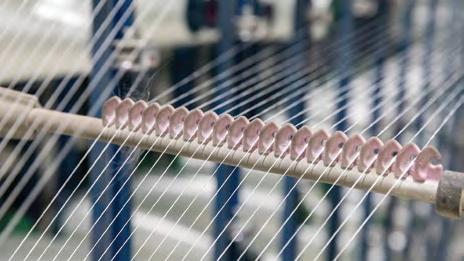
TRANSITIONING A POWER GENERATION SYSTEM TO USE ZERO-CARBON HYDROGEN
The purpose-built plant in the US is expected to start operations in late 2021.
Long Ridge Energy Terminal (Long Ridge), located in Hannibal, Ohio, USA, recently announced plans to transition its 485 MW combined-cycle power plant to run on carbon-free hydrogen. In collaboration with New Fortress Energy (NFE) and GE, Long Ridge intends to begin providing carbon-free power to customers as early as 2021, by blending hydrogen in the gas stream, and transition the plant to be capable of burning 100% green hydrogen over the next decade. With commercial operations planned for November 2021, Long Ridge will be the first purpose-built hydrogen-burning power plant in the US and the first worldwide to blend hydrogen in a GE H-class gas turbine. The plant utilises a GE 7HA.02 combustion turbine which can burn between 15% to 20% hydrogen by volume in the gas stream initially, with the capability to transition to 100% hydrogen over time. Long Ridge has engaged Black & Veatch to assist with developing plans for the plant integration for hydrogen blending and to ensure safe and reliable industrial practices. “We are thrilled to work with the Long Ridge and New Fortress Energy teams on this first-of-its kind GE HA-powered project that will drive a cleaner energy future by utilising hydrogen to ultimately produce carbon-free power”, said Scott Strazik, CEO of GE Gas Power. “As one of the leaders in decarbonisation in the gas turbine industry and the OEM with the most fleet experience in using alternative low heating value fuels including hydrogen, we look forward to applying more than 80 years of experience to help Long Ridge achieve its goal of providing reliable, affordable, and lower-carbon power to its customers”, he added. To support a green hydrogen transition, Long Ridge is teaming with NFE’s new division, Zero, which is focused on investing in and deploying emerging hydrogen production technologies to meet zero emissions targets. NFE’s Zero division will support Long Ridge’s carbon-free power transition as it scales up novel technologies that can produce low-cost hydrogen. “Long Ridge has many advantages in the pursuit of green hydrogen and zero-carbon power and this partnership allows us to get firsthand knowledge and experience blending hydrogen and natural gas in GE turbines”, said Wes Edens, CEO and Chairman of NFE. “Our singular focus has been to identify and support clean technologies that can eventually produce hydrogen at commercially attractive prices. As we continue to make progress in our efforts and advance proof-ofconcept projects, this experience will bring tremendous value”, he added. “As the cost of carbon-free fuels continues to drop, the Long Ridge Energy Terminal is ideally positioned to become a leader in deploying utility-scale green hydrogen solutions and clean energy storage”, said Joe Adams, CEO of Fortress Transportation and Infrastructure Investors LLC (FTAI). Long Ridge is a subsidiary of FTAI. For initial testing of hydrogen blending, Long Ridge has access to nearby industrial byproduct hydrogen. For the production of green hydrogen with electrolysis, Long Ridge has access to water from the Ohio River. Over time, below ground salt formations can be used for large-scale hydrogen storage. “With one of the most efficient power plants in the United States, Long Ridge continues to innovate by being among the first to provide reliable, resilient, on-demand power fuelled by hydrogen”, said Matthew Rinklin, Managing Director at GCM Grosvenor which owns a 49.9% equity interest in Long Ridge. Combined with Long Ridge’s proximity to large scale storage, the plant will be capable of supporting a balanced and diverse power generation portfolio in the future, from energy storage capable of accommodating seasonal fluctuations in renewable energy production, to cost-ef-
fective, dispatchable intermediate and baseload power.

DELIVERING A CARBON-FREE FUTURE WITH GREEN HYDROGEN
Decarbonising the economy to fight climate change is one of the most urgent goals that countries and companies have set for the coming decades.
Wind energy is having a huge impact on reducing the world’s reliance on fossil fuels for electricity generation, but the challenge of decarbonising the economy requires the massive deployment of carbon-neutral fuels in other polluting sectors, such as transport and heavy industry. Green hydrogen from renewable sources is a 100% sustainable, storable, transportable and versatile fuel. It represents a massive opportunity for green transition by driving the transformation of the energy system. Green hydrogen can be produced anywhere and used in sectors that are very difficult to decarbonise, such as aviation and shipping, as well as heavy industry, such as iron and steel, chemicals and glass. Hydrogen can go a long way to reducing emissions at a national and company level. Hydrogen is already used to power industry today, and currently accounts for 1.7% of global annual energy consumption. Just 1% of that hydrogen is generated from green energy sources. The bulk is obtained from natural gas and coal, emitting 830 million tons of CO2 per year. Replacing this current polluting energy consumption would require 820 GW of wind generating capacity, 26% more than the current global installed wind capacity. Long-term forecasts from various industry sources point to hydrogen growing exponentially over the coming decades as transport and heavy industry decarbonise, requiring between 1,000 GW and 4,000 GW of renewable capacity by 2050 to meet demand.
Brande Hydrogen pilot project
Siemens Gamesa is developing, what is said to be, the first pilot project in the world to connect a wind turbine to an electrolyser, with the ability to operate in ‘island mode’, i.e. to drive an electrolysis rig with no link to an electricity grid. With the Brande Hydrogen project, Siemens Gamesa is pioneering a major potential future application for both onshore and offshore wind. The pilot project is now under development, close to Siemens Gamesa’s Danish headquarters in Brande, western Denmark. It includes a 3 MW Siemens Gamesa wind turbine, owned by local partner Uhre Windpower, that will produce clean electricity to power a 400 kW electrolyser. This machine splits water into oxygen and hydrogen so that the hydrogen can be stored and later delivered to customers in the mobility sector. The project is close to obtaining final permits. The first test runs were planned for December 2020 and hydrogen production is expected to start by January 2021. Siemens Gamesa recently signed an agreement with Danish company Everfuel, which will distribute the 100% green hydrogen produced by the facility to refuelling stations across Denmark. For example, in Copenhagen, it will be used to fuel taxis. When fully operational, the project’s single turbine will produce enough hydrogen to fuel around 50 to 70 taxis each day. Carbon-free hydrogen, derived from low-cost, competitive wind power, can be stored and transported for use on demand. This facility will provide insights that will be crucial to scaling up the technology to much larger turbines and wind farms both on land and at sea. “Green hydrogen has the potential to be a game changer in the quest to decarbonise the power supply and solve the climate crisis. Our wind turbines are already making a huge contribution to this effort by providing clean electricity to the grid but, with the storage potential of hydrogen, we can start addressing other key industries. This is an exciting project and I am proud that the ingenuity and commitment of our people is enabling Siemens Gamesa to take the lead. This is the future”, said Andreas
Nauen, CEO, Siemens Gamesa.
With the Brande Hydrogen project, Siemens Gamesa is pioneering a major potential future application for both onshore and offshore wind.

SOFTWARE RELEASED FOR OPTIMAL FORENSIC SCENE DOCUMENTATION
FARO Technologies Inc, a global leader for 3D Metrology, AEC (Architecture, Engineering & Construction), and Public Safety Analytics, recently announced the release of its new FARO Zone 3D 2021 software for crime, crash, fire and security applications. The latest edition of FARO Zone represents a significant software advancement that empowers public safety professionals with even more tools to draw, document, share and analyse forensic scenes, and create 3D scene reconstructions with a high level of realism. For forensic investigators, FARO Zone 3D 2021 provides the ability to reconstruct any scene The FARO Zone 3D 2021 software enables public safety professionals to quickly and easily capture and share accurate data. with complete and accurate documenta- is preserved as a point cloud, it can be used to digitally tion, including factual diagrams, detailed reconstruction obtain accurate measurements, analyse the evidence, analysis and photo-realistic visuals that include grass verify a witness perspective, animate crashes, and more. that grows, multiple light sources and enhanced textures The Advanced option also creates custom virtual reality for stone, brick, wood, metal and water. Additional new scenarios so users can ‘enter’ any scanned scene to take features include analysis of blood cast off stains, bullet photos and measurements, pick up evidence, and swab trajectories through multiple surfaces, automatic import for DNA samples, while completely immersed in VR. of popular crash Event Data Recorder (EDR) data, a 3D roof builder, more than 50 new human models, and a new database for vehicle models and specifications. FARO Zone 3D 2021 also features Zone 2go, whereby professionals can create comprehensive presentations with multiple views of the scene, diagrams, reports, phoFor FARO Laser Scanner users, the new FARO Zone 3D tographs, animations, and fly-throughs. The self-running 2021 ‘Advanced’ option has all the new tools to register viewer can be exported to a USB flash drive and, since no scan data into a 3D point cloud and merge point clouds internet connection is required, it is ideal for jury obserfrom multiple sources including drones. Once a scene vation and deliberation.

HYPERTHERM INTRODUCES EXTREME BEVEL CONSUMABLES FOR PLASMA CUTTING
Hypertherm, a US-based manufacturer of industrial cutting systems and software, recently announced the release of extreme bevel consumables for its MAXPRO200 LongLife air and oxygen plasma cutting system. The consumables, designed for mechanised, robotic, and hand-held cutting, have an aggressive pointed geometry, so that the plasma torch can tilt to an angle of up to 66.5°. The extreme bevel consumables are ideal for a wide range of jobs. This makes the consumables ideal for a wide range of jobs including steep mechanised bevelling, tube and pipe cutting, structural steel work, pressure vessel construction, and hand-held cutting. In addition, they make it easier for operators to see what they are cutting and give them better access to beam flanges and areas with limited clearance for better cuts and fewer secondary operations. The extreme bevel consumables are available for both air and oxygen cutting at 130 amps and 200 amps. MAXPRO200 owners and operators can choose to purchase the consumables separately or as part of a starter kit (part 528058) that includes consumables for all the extreme bevel cutting processes available for this system.

UV-C LIGHTING PRODUCTS FOR DISINFECTION APPLICATIONS
Signify, a world leader in lighting, is accelerating the adoption of UV-C disinfection lighting with new luminaires and equipment for the professional market in Singapore. UV-C lighting is effective in disinfecting air, surfaces, and objects, adding an extra layer of safety for people in homes for the elderly, schools, food and other retail outlets, industry, offices, and public transportation. The effectiveness of Signify’s UV-C light sources in the inactivation of SARS-COV-2, the virus that causes COVID-19, has been validated by tests conducted in the National Emerging Infectious Diseases Laboratories at Boston University, USA. Professional customers in Singapore can now order Philips UV-C disinfection upper air luminaires to disinfect air, Philips UV-C disinfection battens and Philips UV-C disinfection trolleys to disinfect surfaces, and Philips UV-C disinfection chambers to disinfect objects. The UV-C disinfection batten can be used with a control system that contains the appropriate safeguards like the Philips Dynalite PDUVCC control system for UV-C disinfection battens. Signify is contributing an extra layer of safety in a world where organisations are seeking ways to continue operations and provide services to customers. “Now more than ever, disinfecting air, surfaces and objects is critical”, said Mr Jitender Khurana, Country Manager for Singapore and Export Markets at Signify. “To support offices, schools, public transportation, retail outlets and many businesses as they strive to disinfect their spaces, we have leveraged our knowledge and experience in UV-C lighting, making multiple product ranges available for professionals”, he added. Several products are now available in Singapore. These can be used for the disinfection of shopping trolleys; corridors and rooms in schools, hotels and offices; kitchens in restaurants; packages and other items delivered to offices; as well as for the disinfection of trains, planes and buses. Tailor-made solutions can also be developed for customers.
Air disinfection solutions
Signify offers ceiling-mounted Philips UV-C luminaires to disinfect the air. These are installed at a height of at least 2.3 m which, in combination with shielding and optics, ensure that people can continue to work in the lower sections of a room. The UV-C disinfection upper air luminaires can continuously disinfect the air. These luminaires are ideal for use in high-contact areas.
Solutions for disinfecting surfaces
Philips UV-C disinfection battens are installed on the ceiling to disinfect surfaces, outside of operating hours. They should be used in connection with appropriate safeguards, such as the incorporation of the Philips Dynalite PDUVCC control system. Multiple safeguard controls are available using authorised activation with sensor monitoring, door monitoring and emergency override with visible and audible triggers during operation. At controlled times, the UV-C battens disinfect rooms or enclosed spaces. The Philips UV-C disinfection trolley, without sensor and in a 1-arm or 2-arm version, is designed to disinfect up to 36 m2 of circular coverage area / 20 m2 of square coverage area. Integrated safeguard controls include a timer to plan disinfection for a predefined period, remote control, and voice alarm. Additional containment safeguards (such as user manual and mounting instruction) should be deployed together with the UV-C trolley, in order to ensure that no people or animals are exposed to the UV-C rays.
Solutions for disinfecting objects
The Philips UV-C disinfection chamber is used for disinfection of objects for professional use. It is available in two variants - small (77 litres), and medium (110 litres). It can be used for disinfecting objects and shared devices.
Signify offers ceiling-mounted Philips UV-C luminaires to disinfect the air.
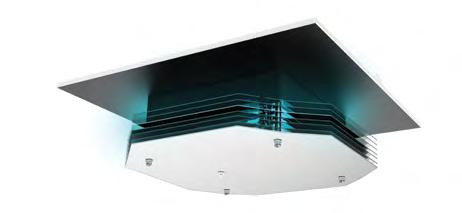

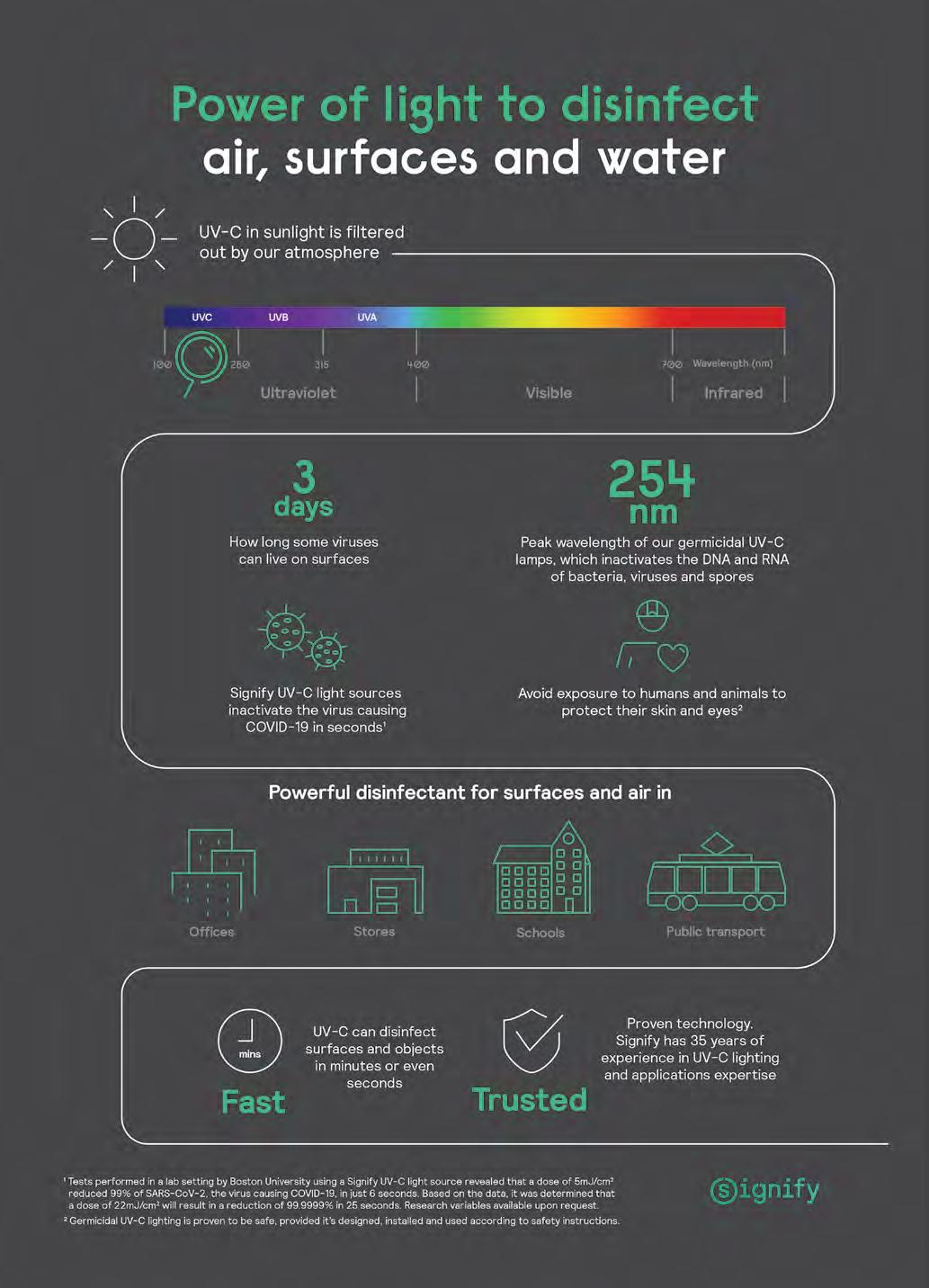
MIT engineers have designed a Velcro-like food sensor, made from an array of silk micro-needles, that pierces through plastic packaging to sample food for signs of spoilage and bacterial contamination. The sensor’s micro-needles, each measuring about 1.6 mm long and 600 microns wide, are moulded from a solution of edible proteins found in silk cocoons. They are designed to draw fluid into the back of the sensor, which is printed with two types of specialised ink. One of these ‘bioinks’ changes colour when in contact with fluid of a certain pH range, indicating that the food has spoiled, while the other changes colour when it senses contaminating bacteria such as E coli. The researchers attached the sensor to a fillet of raw fish that they had injected with a solution contaminated with E coli. After about 16 hours, they found that the part of the sensor that was printed with bacteria-sensing bioink turned from blue to red, indicating contamination. After several more hours, the pH-sensitive bioink also changed colour, signalling that the fish had also spoiled. The results, published in the journal Advanced Functional Materials, are a first step towards developing a new colorimetric sensor that can detect signs of food spoilage and contamination. Such smart food sensors might help head off outbreaks and also prevent consumers from throwing out food that may be past a printed expiration date, but is in fact still consumable. The new food sensor is the product of a collaboration between Assistant Professor Benedetto Marelli, from MIT’s Department of Civil and Environmental Engineering, whose lab harnesses the properties of silk to develop new technologies, and Prof John Hart, Director of the university’s Laboratory for Manufacturing and Productivity. Prof Hart recently developed a high-resolution floxography technique, realising microscopic patterns that can enable low-cost printed electronics and sensors, while the silk micro-needle stamp was developed as a result of Prof Marelli’s research.
ADVERTISERS’ INDEX
Bentley Systems ––––––––––––––––––––– Page 22 to 25 IES Chartered Engineer –––––––––––––––––––– Page 01 IES Membership –––––––––––––––––– Inside Back Cover In conversation, both professors then realised that their expertise could be combined to produce a printed food sensor that monitored food safety. The team then looked to create a sensor that could pierce through the surface of many types of food. The design they came up with consisted of an array of microneedles made from silk. “Silk is completely edible, nontoxic, and can be used as a food ingredient, and it is mechanically robust enough to penetrate through a large spectrum of tissue types, like meat, peaches, and lettuce”, said Prof Marelli. Through their tests, the research team also found their new sensor indicated contamination and spoilage faster than existing sensors that only detect pathogens on the surface of foods, and noted that their solution enabled food quality inspection without opening its packaging. The team is currently looking for ways to speed up the micro-needles’ absorption of fluid, as well as the bioinks’ sensing of contaminants. Once the design is optimsed, they envision the sensor could be used at various stages along the supply chain, from
The method of functioning of the silk micro-needle array food monitoring system. Image: MIT.

operators in processing plants to consumers of food products. IES Railway Systems Handbook ––––– Inside Front Cover Singapore Institute of Technology –––––––– Page 20 & 21 Who’s Who In Engineering, –––––– Outside Back Cover Singapore (3rd Edition)
